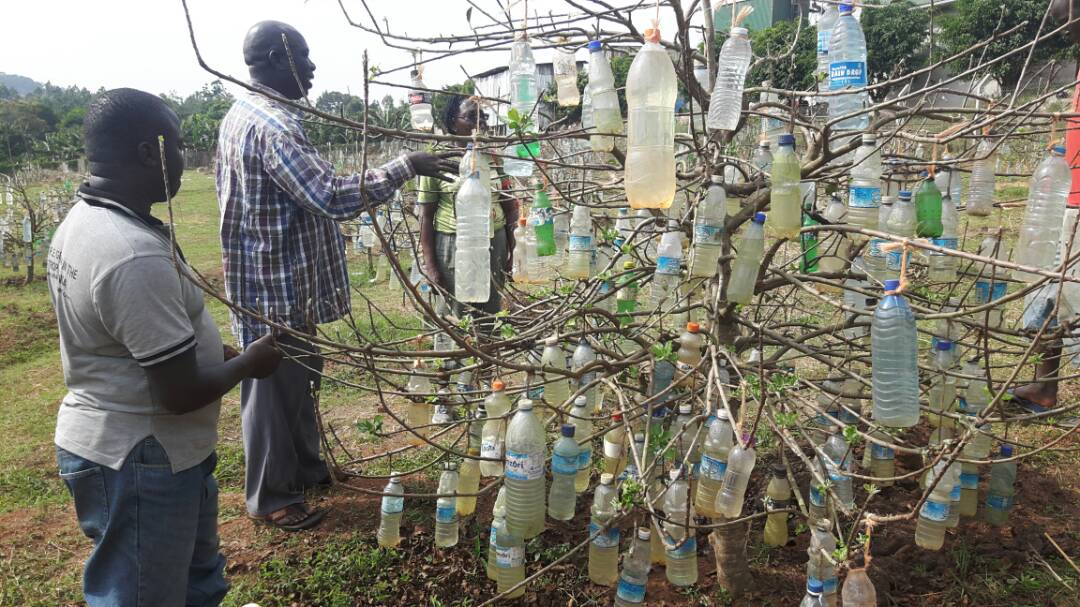We’re looking for wild seedling apples to try out at our East Africa nursery in Uganda.
The apple culture there is a lot like in the USA 150 years ago, with poor roads, no refrigeration, and little ability to spray for pests and disease. We’re looking for apples that are scab-resistant, and lend themselves to old-fashioned preserving, like dehydrating and apple butter. As such, the external appearance is not as important, although pink or red-fleshed apples would add a bit of color to the finished product. Blandly sweet apples can sometimes make killer dried apples.
If you’ve come across some unnamed seedling varieties growing wild in the woods or on an old homestead, which appear to be naturally disease-resistant, this is what we’re looking for, especially if you’re in a hot and humid area. We don’t care about chilling hours, as that is irrelevant; we need to see how it responds to Tropic Apple Culture (leaf stripping), which varies greatly between varieties, and the only way to tell is to try it out.
We can’t offer you any compensation in the line of earthly treasure, as it costs a lot for us to even gather, treat, inspect, and ship the material DHL to Uganda. On the other hand, we’re not asking you to travel to Africa and brave the tsetse flies, typhoid/malaria, M14 rebels, or spitting cobras; there are African guys there more than willing to do that. But your few dollars’ worth of postage has the chance to shape the lives of a lot of people; it only takes one good apple variety to build an entire industry around. It may also be the only chance for your favorite seedling variety to see the light of day as a commercial variety. And what better way to assure it’s survival than to have it planted half a world away, far from any freeze or calamity that might befall your neck of the woods?
This is not an aid project or non-profit; Africa is littered with failed aid projects after the donors leave or the money runs out. This is a for-profit corporation, and the African farmer clients have heavy investments purchasing the trees, clearing the land, and planting the trees; in other words, they have “skin in the game” and care for their investment as such. Because we are not beholden to any donors, NGOs, or government organizations, we’ve been able to take risks and plant dozens of trial varieties in a wide scale without the fear of failure leading to de-funding the organization. This has resulted in quantum leaps in the field of Tropic Apple Culture and improvement in the varieties being planted. Farmers know what risk is, and are willing to take those risks in order to beat out the competition.
We track each tree planted with GPS coordinates, and follow its progress through its lifetime. That being said, nothing happens fast in the apple world, and we plant on vigorous rootstocks; it may be 6-8 years before we know how your variety is performing. But guys like Garfield Schulz were able to see the success of Coconut Crunch far beyond his little borough of Homedale, Idaho, and maybe your seedling find could help out guys like this intrepid farmer below, hacking out an apple orchard in the jungles of Congo, once considered “Deepest Darkest Africa”.
I just need a few sticks of the scionwood put in a plastic bag with a spritz of water in it, and mailed first class. Because we’re not an apple growing area, there’s no restrictions on importing scionwood for the rest of the USA, and no Phytosanitary certificate is needed. I’ll treat it and have it inspected before forwarding on to Uganda, the next shipment being planned for late January. Include any background on the variety that you know, especially the town and state of the tree. Also feel free to name it; the Africans are good about keeping the original name, but will give it an African name if you so desire. Remember that the American Pomological Society protocol is that if the person you are naming it after is still alive, you must get their permission first.
Message me if you’re interested, and I’ll forward you the California mailing address. God bless you, and Happy New Year. - Kevin Hauser, Kuffel Creek Apple Nursery



